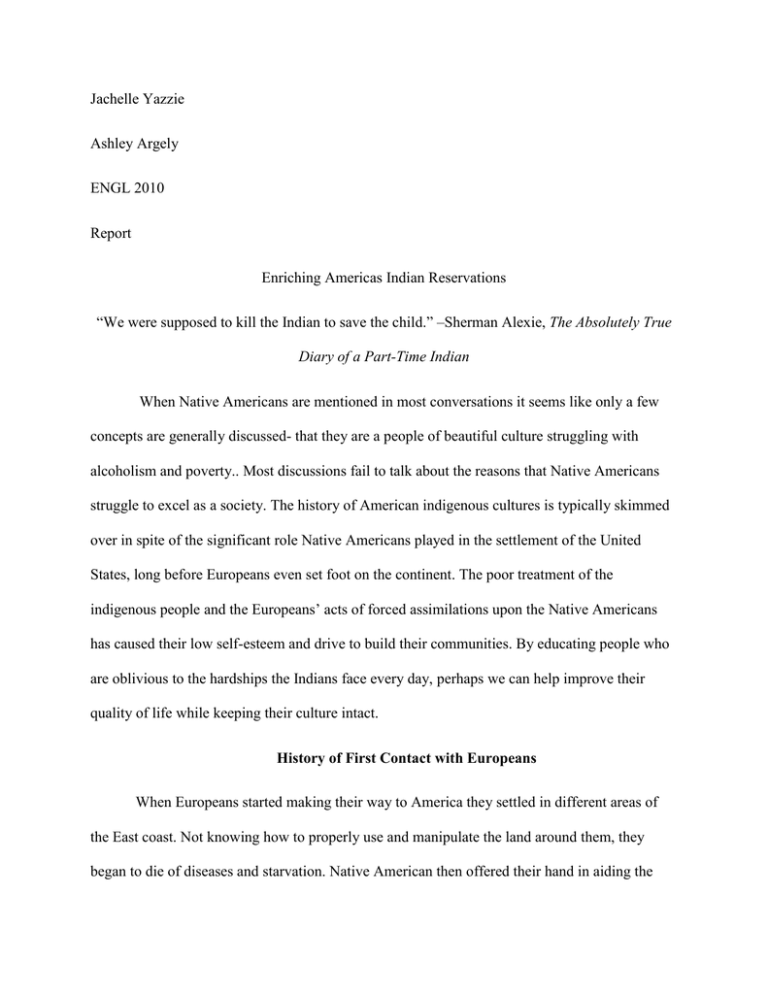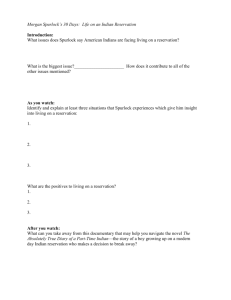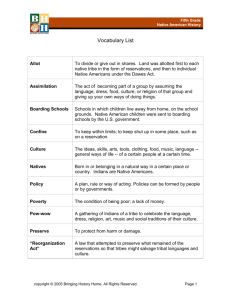Report- Enriching Americas Indian Reservations
advertisement

Jachelle Yazzie Ashley Argely ENGL 2010 Report Enriching Americas Indian Reservations “We were supposed to kill the Indian to save the child.” –Sherman Alexie, The Absolutely True Diary of a Part-Time Indian When Native Americans are mentioned in most conversations it seems like only a few concepts are generally discussed- that they are a people of beautiful culture struggling with alcoholism and poverty.. Most discussions fail to talk about the reasons that Native Americans struggle to excel as a society. The history of American indigenous cultures is typically skimmed over in spite of the significant role Native Americans played in the settlement of the United States, long before Europeans even set foot on the continent. The poor treatment of the indigenous people and the Europeans’ acts of forced assimilations upon the Native Americans has caused their low self-esteem and drive to build their communities. By educating people who are oblivious to the hardships the Indians face every day, perhaps we can help improve their quality of life while keeping their culture intact. History of First Contact with Europeans When Europeans started making their way to America they settled in different areas of the East coast. Not knowing how to properly use and manipulate the land around them, they began to die of diseases and starvation. Native American then offered their hand in aiding the Europeans on how to properly grow food in gardens. (Frazier 8). The Indians were people who would not use more than they needed and they had a unique relationship with the land around them (Olsen and Wilson 17). Native Americans were not aware of the value of materialistic items as well as uneducated which made it all too easy for Europeans to take advantage of them. The Indians have continuously have the bad end of change by having to accommodate and change their way of life that they have been practicing long before there were any European explorers. Calvin Martin, a Native American historian stated, “We presume to document and interpret the history of a people whose perception of the world for the most part eludes us, whose behavior, as a result, is enigmatic… To ignore the Indians thoughout the world is to continue writing about ourselves to ourselves.” (Begay 3) He explains that Native American history is hardly told by Native Americans and that US History tends to document events that seem to avoid tragic events. For example, The Trail of Tears, that was part of the Indian Removal Act by President Andrew Jackson. It required all Indians living East of the Mississippi River to move West onto reservations. 4,000 Cherokee people died on the march to the west due to starvation, disease and exhaustion (Cherokee.org). The reservations were operated poorly and usually by government officials who were unfit to perform the duties honorably. Diseases on the reservations wiped out one fourth of the eighteen thousand people held there (Olsen & Wilson 43). Native American children were required to leave their families and attend boarding schools, they were given Christian names, forbidden to speak their language and had to portray an image of being ‘proper’. Simon Ortiz describes this treatment as the Indians were being told that it was no longer acceptable to be Indian “…discouraged from pressing for our natural rights as Indian human beings” (Ortiz 35). Historians believe that the reason Native Americans were unable to fight back against the assimilation was because their inability to come together and organize to have any noticeable effect (Frazier 11). The poor treatment of Native Americans in history had an impact on their identity today living on reservations. Poverty & Unemployment Among Native Americans Massive amounts of poverty exist on Indian reservations. Most people make the assumption that Indian casinos are bringing in enough money to sustain the needs of the tribes, which is not the case. The Blackfoot Reservation in Montana has a daunting unemployment rate of sixty-nine percent; during the Great Depression the highest unemployment rate was just twenty-five percent (Rodgers 27). In the documentary film 30 days, Morgan Spurlock spends a month on the Navajo reservation in Gallop, New Mexico, and discovers that some Native Americans mimic the acts of immigrants from Mexico and leave their homes and families to go work somewhere in the country to be able find work and send money home, although the Indians live in the their own country. “We were a poor family, always on the verge of financial disaster, though our parents always managed to feed us and keep us in clothing. We had the problems, unfortunately ordinary, or many Indian families who face poverty on a daily basis, never enough of anything, the feeling of denigrating self-consciousness, alcoholism in the family and the community, the feeling that was falling apart though we tried desperately to hold it together.” -Simon Ortiz 33 Twenty-nine percent of Indian do not have health care insurance. The Indian Health Care Improvement Act, established in 1976 has not been enforced since 1992.The act was put into place to aid Indians in having a healthier way of life and to have basic health needs met (Rodger 37). Native Americans receive less services than any other group of people. Rodger argues about Native American communities, “Failure to address poverty causes deprivation and hardships in these communities today, and robs the next generation of any opportunity to succeed and thrive tomorrow,” (Rodger 56). The lack of opportunities and funds to help reservations have a stable living environment is sadly still true today. Personal Experience My parents both grew up on the Navajo reservation, my mother is from Aneth, Utah and my father is from Shiprock, New Mexico. My mom lived on one of the poorer reservations in the area. She grew up with ten brothers and sisters in a small hogan that had no plumbing, no electricity and slept on sheep’s wool on the dirt floor. My father did not attend the schools on the reservation, he was sent to live with a Mormon family in Salt Lake City, Utah. His foster family was strict in their Mormon beliefs so he wasn’t allowed to practice any of his spiritual beliefs and was also instructed that he was not allowed to speak Navajo to his other Native foster brother or in that case ever. Even though they received their education off of the reservation, the effect of growing up in society that didn’t support finishing school influenced their enthusiasm to receive a diploma. My siblings and I did not grow up on the reservation, although the characteristic still loomed over our family. My mother and father never received their high school diploma, which seems to trickle down into the mind set of us as children. There are five children in my family. I am the second to get my high school diploma and the first to attend college. The graduation rate of Native Americans who receive a high school diploma is fifty-one percent, which concludes that few Native American receive any education beyond middle school and high school (Sheehy 26). Finishing school on the reservation is not considered an important trait to succeed as it should be, due to different factors such as, lack of transportation, unable to meet financial needs, family dysfunction, or by the setbacks of alcoholism. In one of Sherman Alexie’s novels he mentions the lack of motivation because there is no support, saying “They dreamed about being something other than poor, but they never got the chance to be anything because nobody paid attention to their dreams” (Alexie 11). The reservations’ negative culture has the potential to affect Indians because of struggles with lack of job opportunities and the feeling of no selfworth. In Sherman Alexie’s novel he elucidates on the feeling of hopelessness the Native Americans have before they have a chance to show any kind of hope of leaving behind the reservation. “It suck to be poor, and it sucks to feel that you somehow deserve to be poor. You start believing that you’re poor because you’re stupid and ugly. And then you start believing that you’re stupid and ugly because you’re Indian. And because you’re Indian you start believing you’re destined to be poor. It’s an ugly circle and there’s nothing you can do about it.” (Junior, The Absolutely True Diary of a Part-Time Indian 13). You can sense the feeling of no hope and having nothing to rely on, feeling like you are already going to fail no matter how hard you attempt. The biggest obstacle Native American still need to defeat is the reckless use of alcohol that surges through the reservation and prevents any kind of substantial progress in the community. Alcoholism Alcoholism is a problem that is comparable to a plague on many reservations; it has done nothing good for the Indians but ruined families and bring down lives. . Alcohol took a hold of them in such a way that they were considered “drunken Indian.” According to historians Owen and Wilson they were described as, “a pitiful creature unable to resist the bottle and incapable of controlling the emotional effects of drinking” (Owen & Wilson 53). The alcoholism rate on the reservation is six times the national average and seventy-five percent of deaths on the reservation are in connection to alcohol such as car accidents, liver problems, diabetes and suicide (Moore 45). The bottle tends to look more enticing to those who struggle with the strains of poverty, poor education, high unemployment rates and family difficulties. If Indian were able to control their thirst for alcohol and put their energy toward something they care for and found important they would be able to work more efficiently toward a healthier better life. What Hold Indians Together as a Culture The Native Americans have faced all these hardships and trials, yet they still have had their share of victories. What holds them together is their ability to endure and adapt to their ever changing surroundings all while keeping true to their heritage and beliefs. Robert McPhrson makes a good example of their strength by stating, “But, in spite of the complexity and change, the reader will find the constant theme of the people’s love for the land and their desire to maintain their culture identity. These two are inseparably intertwined, treading throughout these tribal histories.” (McPherson 24). McPherson is referring to the Indian’s strength in staying true to themselves, no matter how torn down they become they still perform their rituals and hold tight to their spiritual beliefs. Individuals within the reservation community are taking a stand to make changes for the better. They are organizing and leading programs, events and support groups for the Native Americans to take advantage of. All the beneficial programs keep in mind the Native Americans unique beliefs and are sure to embrace the culture. To name a few things that are being done. Schools on the Navajo reservation are teaching in the Navajo language from kindergarten through fourth grade, then from there on it is fifty-fifty until they graduate (30 Days). The American Indian Relief Council, which was established to aid Native Americans with a variety of necessities. They offer services such as finding employment services to produce jobs on the reservations. The services that are involved with reservation charities are usually run by Native Americans or someone who have experienced life on the rez first hand. Conclusion What European expansion did to the Native American tribes in history is something we no longer have the power to change. My parent’s decision to move off the reservation is something I will forever be grateful for. The education system on the reservation needs more support for the children and teens currently attending school. They need something to give them the motivation to continue to finish their education. Alcoholism among Native Americans needs to be addressed to assist this once a proud nation away from the temptations of bottle. I fear that if these issues continue to be ignored then American Indians on the reservation, their children, and their grandchildren for generations to come will continue to slowly lose their distinctive culture. Native Americans have done a sensational job of keeping true to themselves and as Simon Ortiz states flawlessly, “By the retention and the inspiration of our native heritage, values, philosophies, and languages, we would know ourselves as a strong and enduring people.”(Ortiz 35). Although there are programs that are aiding the Indian, more can still be done by outside sources. By informing people who are oblivious to the situations of local tribes are facing, I believe Native Americans could learn to overcome their tribulations and strive to live their lives healthier, stronger, and spiritually. Work Cited “About AIRC”. American Indian Relief Couuncil. N.D. 6 Aug. 2014. Alexie, S. The Absolutely True Diary of a Part-Time Indian. New York: Hachette Book Group, Inc. 2007. Print. Begay, D., (Eds.). A History of Utah’s American Indians. Logan, UT: Utah State University Press. 2004. Print. Elk, Black., Erdrich, Louise., Momaday, N. Scott., Hogan, Linda., Dorris, Michael., Hernandez, Ines. Growing Up Native American. New York: Harper Collins Publishers Inc. 1993. Print. Frazier, Ian. On The Rez. New York: Picador. 2000. Print. “Life on an Indian Reservation” 30 Days: Season 3. Silverman, Ben., Spurlock, Morgan. FX Networks, 2009. DVDOlsen, James S., Wilson, Raymond. Native Americans In The Twentieth Century. Chicago, IL: University of Illinois Press. 1984. Print Rodgers. Tom. “Native American Poverty.” Spolight On Poverty N.D. 6 Aug. 2014





